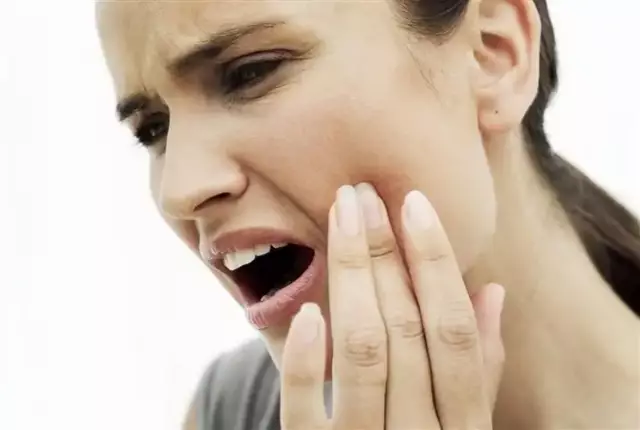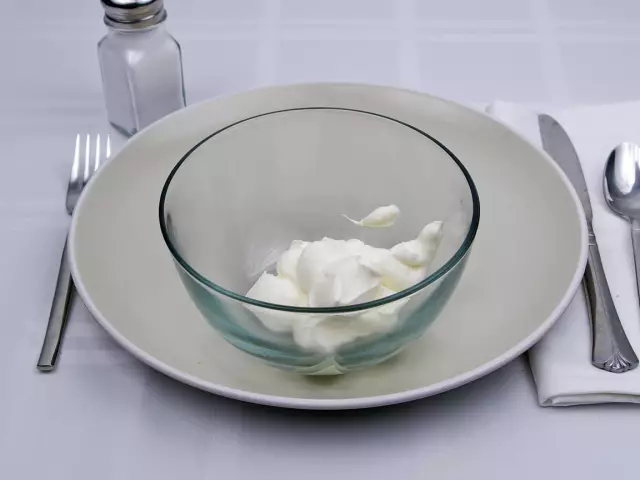- Author Rachel Wainwright [email protected].
- Public 2023-12-15 07:39.
- Last modified 2025-11-02 20:14.
Tebikur
Tebikur: instructions for use and reviews
- 1. Release form and composition
- 2. Pharmacological properties
- 3. Indications for use
- 4. Contraindications
- 5. Method of application and dosage
- 6. Side effects
- 7. Overdose
- 8. Special instructions
- 9. Application during pregnancy and lactation
- 10. Use in childhood
- 11. In case of impaired renal function
- 12. For violations of liver function
- 13. Use in the elderly
- 14. Drug interactions
- 15. Analogs
- 16. Terms and conditions of storage
- 17. Terms of dispensing from pharmacies
- 18. Reviews
- 19. Price in pharmacies
Latin name: Tebicur
ATX code: D01BA02; D01AE15
Active ingredient: terbinafine (Terbinafine)
Producer: Nobel Ilach Sanayi ve Tijaret A. Sh. (Nobel Ilac Sanayii ve Ticaret AS) (Turkey)
Description and photo update: 2020-23-01
Prices in pharmacies: from 174 rubles.
Buy

Tebikur is an antifungal agent for systemic and external use with a wide spectrum of activity.
Release form and composition
Dosage forms of Tebikur:
- tablets 250 mg: white, round, with a chamfer, on one side there is a risk (in blisters made of polyvinyl chloride / polyethylene / polyvinylidene chloride film and aluminum foil, 14 pcs., in a cardboard box one or two blisters along with instructions for use of the drug);
- cream for external use 1%: white, uniform consistency, has a mild characteristic odor (in aluminum tubes of 15 g, in a cardboard box one tube and instructions for use of Tebikur).
Composition of 1 tablet:
- active ingredient: terbinafine - 250 mg (in the form of terbinafine hydrochloride - 281.25 mg);
- additional substances: MCC (microcrystalline cellulose) PH 101 and PH 102, hypromellose-15cP, colloidal silicon dioxide, croscarmellose sodium, magnesium stearate.
Composition of 1 g of cream:
- active ingredient: terbinafine (in the form of terbinafine hydrochloride) - 10 mg;
- additional substances: cetyl palmitate, sorbitan stearate, stearic alcohol, benzyl alcohol, cetyl alcohol, isopropyl myristate, sodium hydroxide, polysorbate 60, purified water.
Pharmacological properties
Pharmacodynamics
Terbinafine is a member of the allylamine group with a broad spectrum of antifungal activity. When used in low concentrations, it has a fungicidal effect on yeast fungi, mainly Candida albicans, mold fungi (for example, Scopulariopsis brevicaulis), dermatophytes (Trichophyton verrucosum, Trichophyton mentagrophytes, Trichophyton rubrum, Trichophyton cannabis cannaceum tons, Trichophyton tons), Trichophyton tons some dimorphic mushrooms. On fungi of the genus Candida and its mycelial forms, terbinafine has a fungicidal or fungistatic effect (depending on the type of fungus).
The mechanism of action of terbinafine lies in the destruction at an early stage of the biosynthesis of ergosterol, which is the main component of the cell membrane of the fungus, by suppressing the activity of the enzyme squalene epoxidase. The deficiency of ergosterol arising during this process contributes to the intracellular accumulation of squalene, which in turn leads to the death of the fungal cell.
Oral administration of Tebikur is not effective in the treatment of varicoloured lichen caused by Malassezia furfur, Pityrosporum ovale.
The effect of terbinafine on the cytochrome P 450 system in humans has not been noted, therefore, it does not affect the metabolism of hormones and other drugs.
Pharmacokinetics
Pharmacokinetic characteristics of oral terbinafine:
- absorption: well absorbed, in the amount of half of the dose taken ~ 48 minutes after the intake; after 4.6 hours, the completely absorbed substance is distributed in the body. A single dose of 250 mg leads to the achievement of the maximum concentration of the drug in the blood plasma (C max) after 1-2 hours, while the C max is 0.97 μg / ml. Bioavailability is 80%. Food intake has no effect on this indicator;
- distribution: quickly spreads in tissues, penetrates into the nail plate and the dermal layer of the skin. It is present in the secretion of the sebaceous glands, accumulates in high concentration in the skin and subcutaneous tissue, hair follicles and hair. The connection of terbinafine with proteins is 99%. The half-life (T 1/2) is 16-18 hours, T 1/2 of the terminal phase is 200-400 hours;
- metabolism: the biotransformation of the substance is carried out in the liver, the resulting metabolites do not have pharmacological activity;
- excretion: ~ 80% of the dose taken is excreted in the urine as metabolites, the rest (~ 20%) - in the feces. Terbinafine does not accumulate in the body. Excreted in breast milk. The rate of excretion of the substance is reduced if patients have renal and / or hepatic insufficiency.
When terbinafine is used externally, the systemic exposure is minimal, since less than 5% of the dose enters the systemic circulation.
Indications for use
Tebikur tablets are prescribed for the treatment of the following fungal diseases:
- severe, widespread dermatomycosis of the smooth skin of the trunk and extremities, in which systemic therapy is required;
- candidiasis of the mucous membranes and skin;
- onychomycosis;
- mycoses of the skin and nails caused by Trichophyton (for example, T. rubrum, T. verrucosum, T. mentagrophytes, T. violaceum), Epidermophyton floccosum, Microsporum canis;
- mycoses of the scalp: microsporia, trichophytosis.
Cream for external use Tebikur is used for local therapy of skin mycoses:
- Pityriasis versicolor, or versicolor versicolor, caused by Pityrosporum orbiculare (another name for Malassezia furfur);
- diaper rash and other yeast infections of the skin, mainly caused by members of the genus Candida (for example, Candida albicans);
- fungal infections of the skin, including mycoses of the feet (foot fungus), athlete's foot (Tinea cruris), fungal infections of the smooth skin of the body (Tinea corporis) caused by dermatophytes such as Trichophyton (e.g. T. mentagrophytes, T. gypseum, T. rubrum, T. interdigitale, T. verrucosum, T. Tonsurans, T. violaceum), Epidermophyton floccosum and Microsporum canis, - treatment and prevention.
Contraindications
Absolute:
- CRF (chronic renal failure) with creatinine clearance (CC) less than 50 ml / min (for tablets);
- chronic or active liver disease (for pills);
- children under 3 years of age (and body weight up to 20 kg) - for tablets; up to 12 years old (for cream);
- pregnancy (for pills);
- period of breastfeeding;
- hypersensitivity to the active or auxiliary components of the drug.
Relative (Tebikur should be used with precautions):
- renal and / or hepatic impairment;
- tumors;
- limb vascular pathology;
- oppression of bone marrow hematopoiesis;
- metabolic diseases;
- alcoholism;
- pregnancy (for cream).
Tebikur, instructions for use: method and dosage
Pills
Tebikur tablets are administered orally.
The dosage regimen and duration of therapy is set by the doctor individually for each patient, depending on the localization of the process and the severity of the disease.
Adult patients are usually prescribed 1 tablet (250 mg) once a day.
The duration of therapy for fungal skin infections, depending on the location of the infection:
- interdigital, plantar or sock style: 2-6 weeks;
- mycoses of the legs, mycoses caused by Candida: 2-4 weeks;
- mycoses of the trunk: 4 weeks;
- mycoses of the head, caused by Microsporum canis: more than 4 weeks.
The duration of therapy for onychomycosis is from 6 to 12 weeks. In young patients, as well as with lesions of the nails of the fingers and toes (except for the big toe), the duration of therapy may be less than 12 weeks. In the presence of a big toe infection, a 3-month course of drug therapy is usually sufficient. Sometimes, in the case of a slow growth rate of nails, the treatment can be longer (up to 6 months or more).
For children, the dose of Tebikur is set depending on body weight (frequency of application - once a day):
- 20-40 kg: appoint half the daily dose of adults (125 mg, or ½ tablet);
- > 40 kg: Adult dose (250 mg, or 1 tablet).
The duration of therapy in children with mycoses of the scalp is about 4 weeks, with infection with Microsporum canis - it can be longer.
Patients with renal insufficiency (CC <50 ml / min) need to halve the daily dose of Tebikur (125 mg, or ½ tablet).
Elderly people do not need to adjust the dose.
Cream for external use 1%
Tebikur cream is intended only for external use in adults and children over 12 years old.
The drug is applied 1-2 times a day with a thin layer on the previously cleaned and dried affected skin and adjacent areas and gently rubbed. If the infection is accompanied by diaper rash (in the interdigital spaces, in the groin, between the buttocks, under the mammary glands), the skin at the site of application of the cream can be covered with clean gauze, especially at night.
The average duration of therapy and the frequency of use of Tebikur, depending on the location of the infection:
- Pityriasis versicolor, or versicolor versicolor: 2 weeks, 1-2 times a day;
- candidiasis of the skin: 1-2 weeks, 1-2 times a day;
- dermatomycosis of the feet, legs and trunk: 1 week, 1 time per day.
In the first days of treatment, as a rule, there is a decrease in the severity of the clinical manifestations of the disease. It is important to complete the full course of therapy in compliance with the recommendations for use, otherwise, due to premature termination of treatment or its irregularity, the risk of re-infection increases.
If there are no signs of improvement within 1-2 weeks of therapy, it is necessary to verify the diagnosis.
Side effects
Possible unwanted reactions from systems and organs when taking Tebikur tablets:
- digestive system: abdominal pain, nausea, diarrhea, indigestion, feeling of fullness in the stomach, loss of appetite; rarely - a violation of taste, in some cases until a complete loss of taste sensitivity (recovers after several weeks after the end of therapy); very rarely (no more than 0.01-0.1%) - hepatobiliary disorders (increased activity of hepatic transaminases, cholestatic jaundice, liver failure);
- hematopoietic system: very rarely - thrombocytopenia / agranulocytosis, lymphopenia, neutropenia;
- musculoskeletal system: myalgia, arthralgia;
- allergic reactions: rash / urticaria; very rarely - Lyell's syndrome (toxic epidermal necrolysis), Stevens-Johnson syndrome (malignant exudative erythema), worsening Liebman-Sachs disease (SLE, or systemic lupus erythematosus), anaphylactoid reactions.
When the cream is applied externally, allergic reactions may occur, in the places of application (rarely) - redness, burning and itching.
Overdose
In case of an overdose of Tebikur tablets, pain in the lower abdomen, in the epigastric region, headache, dizziness, nausea, vomiting, and frequent urination may occur.
Overdose cases with external use of the drug have not been registered. If the cream was accidentally taken orally, the same symptoms may develop as with an overdose of tablets.
If you suspect intoxication with terbinafine, the stomach is washed, activated charcoal is prescribed, and if necessary, symptomatic therapy is performed.
special instructions
With irregular use of terbinafine or early termination of treatment, the risk of relapse of the disease is not excluded.
Concomitant diseases can serve as a factor leading to an increase in the duration of therapy. With onychomycosis, the condition of the nails may affect the duration of treatment. If signs of improvement are not observed within 2 weeks of using Tebikur, the causative agent of the disease and its sensitivity to terbinafine should be re-determined.
In the treatment of onychomycosis, systemic use is advisable only with total damage to most nails, the presence of pronounced subungual hyperkeratosis and the lack of effect from previous local therapy.
The clinical response to the treatment of onychomycosis, as a rule, is noticeable only several months after the mycological cure confirmed by laboratory studies and the completion of the course of therapy. This period is due to the rate of regrowth of a healthy nail. It is not required to remove the nail plates in the treatment of onychomycosis of the hands for 3 weeks, onychomycosis of the feet - for 6 weeks.
In patients receiving therapy for liver disease, a decrease in terbinafine clearance is possible.
In the course of treatment, the indicators of the activity of hepatic transaminases in the blood serum should be monitored. There have been rare cases of cholestasis and hepatitis after 3 months of using Tebikur. If there are signs of liver dysfunction such as loss of appetite, persistent nausea, abdominal pain, weakness, jaundice, discolored stools or dark urine, the drug should be stopped immediately.
In extremely rare cases, terbinafine has caused exacerbation of psoriasis, so patients with this diagnosis should use Tebikur with extreme caution.
Terbinafine therapy involves general hygiene practices to prevent re-infection through shoes or clothing. During treatment (after 2 weeks) and at the end of the use of the product, it is recommended to perform antifungal treatment of stockings, socks and shoes.
When using Tebikur cream, it is important not to let it get into the eyes, as this may cause irritation. If this does happen, you must immediately rinse your eyes with running water, and if persistent irritation occurs, seek the advice of a specialist.
The appearance of allergic reactions is the basis for the cancellation of Tebikur.
Influence on the ability to drive vehicles and complex mechanisms
Terbinafine has no effect on a person's ability to drive a car or other types of transport, as well as work with complex mechanisms and engage in other activities that require increased concentration of attention.
Application during pregnancy and lactation
Tebikur tablets are contraindicated for women during pregnancy and breastfeeding (since there is insufficient data on the safety and efficacy of the drug in this group of patients).
Tebikur cream for use during lactation is contraindicated (or the issue of transferring the child to artificial feeding should be resolved).
It is possible to use the cream during gestation, provided that the potential benefit to the mother exceeds the possible risk to the fetus.
Pediatric use
Tebikur tablets are contraindicated in children under 3 years of age and with a body weight of less than 20 kg.
The preparation in the form of a cream for external use may be used in the treatment of pediatric patients over the age of 12 years.
With impaired renal function
The presence of a diagnosis of chronic renal failure is a contraindication to taking Tebikur tablets.
With CC less than 50 ml / min, the daily dose is ½ tablet (125 mg).
Tebikur should be used with caution in patients with renal failure.
For violations of liver function
In the presence of an active or chronic form of liver disease, taking Tebikur tablets is contraindicated.
Patients with hepatic impairment and those suffering from alcoholism should use the drug with caution.
Use in the elderly
In elderly patients, there is no need to adjust the dose of the drug.
Drug interactions
When taking Tebikur tablets together with other substances / preparations, the following interactions are possible:
- cimetidine and other inhibitors of cytochrome P 450 isoenzymes: slow down the metabolism and excretion of terbinafine from the body;
- rifampicin and other inducers of cytochrome P 450 isoenzymes: accelerate the excretion of terbinafine from the body;
- caffeine: terbinafine prolongs the T 1/2 of caffeine by 31% and reduces its clearance by 21%;
- ethanol and other drugs that have a hepatotoxic effect: when taken together with terbinafine, the risk of developing drug damage to the liver increases;
- oral contraceptives: the use of terbinafine while taking oral contraceptives can lead to menstrual irregularities;
- fluvoxamine, desipramine, other SSRIs (selective serotonin reuptake inhibitors) and tricyclic antidepressants; propafenone, flecainide and other antiarrhythmics; haloperidol, chlorpromazine, and other antipsychotic drugs; propranolol, metoprolol and other beta-blockers; selegiline (MAO-B inhibitor): terbinafine interferes with the metabolism of these drugs;
- digoxin, phenazone, warfarin: terbinafine has no effect on the clearance of the listed substances.
There are no data on the drug interaction of Tebikur cream when applied externally against the background of therapy with other drugs.
Analogs
Tebikur's analogs are Atifin, Binafin, Lamisil, Lamisil Dermgel, Lamisil Uno, Lamitel, Lamifungin, Mikonorm, Terbized-Agio, Terbizil, Terbiks, Terbinafin, Terbinafin Canon, TerbinaFin Sandoz, Terbinafin-MERBINAFIN-TerbinaFine, Terbifin, Thermikon, Tigal-Sanovel, Ungusan, Fungoterbin, Exeter, Exifin, ECO-Terbin, etc.
Terms and conditions of storage
Keep out of the reach of children.
Store in a dry place, away from sunlight, at a temperature not exceeding 25 ° C.
Shelf life is 2 years.
After the expiration date indicated on the package, it is prohibited to use the drug.
Terms of dispensing from pharmacies
Dispensed by prescription.
Reviews about Tebikur
Patients and specialists leave few, but mostly positive, reviews about Tebikur. In their opinion, the drug is an excellent antifungal agent both in the form of tablets and in the form of a cream for external use. Separately, its availability in pharmacies and budgetary cost are noted. To obtain a faster result, it is advised to follow the dosage regimen indicated in the instructions.
The disadvantage of the Tebikur tablet form, users consider the presence of adverse reactions from the digestive tract. There are complaints about a small amount of cream in the tube. Due to the fact that the cream is absorbed for a long time, it is recommended to apply it at night.
The price of Tebikur in pharmacies
In pharmacy chains, the approximate price for Tebikur is:
- tablets 250 mg: per pack of 14 pcs. - 434-575 rubles;
- cream for external use 1%: for a tube of 15 g - 157-224 rubles.
Tebikur: prices in online pharmacies
|
Drug name Price Pharmacy |
|
Tebikur 1% cream for external use 15 g 1 pc. 174 r Buy |
|
Tebikur 250 mg tablets 14 pcs. 253 r Buy |

Anna Kozlova Medical journalist About the author
Education: Rostov State Medical University, specialty "General Medicine".
Information about the drug is generalized, provided for informational purposes only and does not replace the official instructions. Self-medication is hazardous to health!






